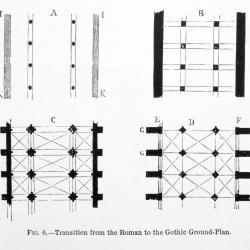One Thousand Years of Church Architecture
The Gothic Structural Revolution: A Dialectic In this section, use the interactive feature "1000 Years of Church Architecture" to better understand the Gothic Structural Revolution (click on the terms Early Christian, Romanesque, and Gothic). Following Viollet-le-Duc's premise of Gothic understood as "An Entire Revolution in the Art of Building."
Thesis: An Early Christian (Viollet-le-Duc calls it "Roman") wooden-roofed basilica-- perhaps Santa Sabina in Rome. The edifice has slender marble columns and thin walls punctuated with enormous windows. Light-reflective materials (marble, mosaic, silver, gold) contribute to a brilliantly-lit, spatially-unified interior.
Antithesis: Romanesque builders have created a totally-vaulted basilica with groin vaults in the aisles and groin or barrel vaults in the main vessel. Since the heavy masonry of the vaulting creates considerable outward thrust it has been necessary to thicken the main supports (no longer columns but compound piers) and outer walls which are stiffened by shallow buttresses. Windows are small. The interior is now dark and optical continuity is obstructed by the substantial supports. An example of such a structure with a barrel vault is Saint-Sernin in Toulouse.
Synthesis: Gothic combines the optical unity and spaciousness of A with the totally-vaulted structure of B. Amiens Cathedral provides the best example. This revolution in architecture is facilitated through the deployment of 3 structural devices.
a) The pointed arch. Appropriated from Islamic sources and applied to reduce outward thrust.
b) The ribbed vault. Also from Islamic, Roman and Byzantine sources, but not rendered in thin masonry, greatly reducing the weight of the superstructure.
c) Exterior supports or culées (labeled as G on the Viollet-le-Duc plan). It is as if the outer wall (labeld F) has been broken into segments, each of which is rotated 90 degrees to provide rigid transverse supports for exposed arches (flying buttresses) which support the high vaults.
Thanks to this structural revolution Gothic is able to return to the unencumbered interior space and brilliant light (now flitering through stained glass) of the first Christian basilicas in Rome.



